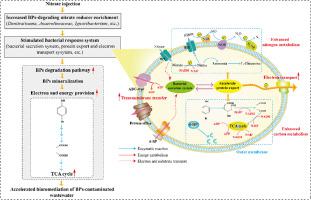Water Research ( IF 11.4 ) Pub Date : 2023-06-08 , DOI: 10.1016/j.watres.2023.120200 Jing Wang 1 , Qiang Chi 1 , Ling Pan 1 , Ranran Zhang 1 , Yang Mu 2 , Jinyou Shen 1

|
Due to the recalcitrant nature of halogenated phenol, conventional anaerobic bioprocess is often limited by low removal efficiency and poor process stability. At the presence of electron acceptors such as nitrate, 4-bromophenol (4-BP) removal efficiency is significantly higher than that in the anaerobic control system, but the mechanism involved is still unclear. Therefore, an up-flow nitrate-reducing bioreactor (NRBR) was designed and consecutively performed for 215 days to explore the synergistic mechanism for BPs biodegradation and nitrate reduction. Complete 4-BP biodegradation could be obtained in NRBR at HRT and 4-BP loading rate of 24 h and 0.29 mol m − 3 d − 1, while the TOC removal and nitrate reduction efficiencies were as high as 91.33±2.11% and 98.31±1.33%, respectively. Population evolution analyses revealed that the microorganisms involved in 4-BP debromination and biodegradation (Candidatus Peregrinibacteria, Denitratisoma, Anaerolineaceae and Ignavibacterium) as well as nitrate reduction (Denitratisoma, Anaerolineaceae, Limnobacter and Ignavibacterium) were significantly enriched in NRBR. Major intermediates during 4-BP biodegradation, including 4-bromocatechol, 4‑bromo-6-oxo-hexanoic acid and succinic acid were identified, while a distinct 4-BP biodegradation pathway via hydration, aromatic-ring cleavage, hydrolysis debromination and oxidation was expounded. Metagenomic analysis indicated that oxidation (had, pht4, boh, butA), hydrolysis debromination ((S)-2-haloacid dehalogenase) and bio-mineralization (gabD, sdhA) of 4-BP were largely enhanced in NRBR. Moreover, carbon, nitrogen, energy and amino acid metabolisms were significantly facilitated with the injection of nitrate in order to provide energy and electron, thus enhanced microbial activities and enzymatic reactions in NRBR. The proposed mechanism provides new insights into our mechanistic understanding of halogenated phenol biodegradation and the development of sustainable bioremediation strategies.
中文翻译:

硝酸盐还原系统中增强 4-溴苯酚生物降解的新见解:工艺性能和机制
由于卤代酚的顽固性,传统的厌氧生物工艺常常受到去除效率低和工艺稳定性差的限制。在硝酸盐等电子受体存在下,4-溴苯酚(4-BP)的去除效率显着高于厌氧控制系统,但其机制仍不清楚。因此,设计了上流式硝酸盐还原生物反应器(NRBR)并连续运行215天,以探索BPs生物降解和硝酸盐还原的协同机制。在HRT和4-BP负载率为24 h和0.29 mol m − 3 d − 1的条件下,NRBR可以实现4-BP的完全生物降解,而TOC去除率和硝酸盐还原率高达91.33±2.11%和98.31±分别为1.33%。种群进化分析表明,参与 4-BP 脱溴和生物降解的微生物(Candidatus Peregrinibacteria、Denittisoma、Anaerolineaceae和Ignavibacteria)以及硝酸盐还原(Denitratisoma、Anaerolineaceae、Limnobacter和Ignavibacteria)在 NRBR 中显着富集。鉴定了 4-BP 生物降解过程中的主要中间体,包括 4-溴儿茶酚、4-溴-6-氧代-己酸和琥珀酸,同时确定了通过水合、芳环裂解、水解脱溴和氧化的独特 4-BP 生物降解途径。阐述了。宏基因组分析表明,4-BP 的氧化(had、pht4、boh、butA)、水解脱溴((S)-2-卤酸脱卤酶)和生物矿化(gabD 、 sdhA)在 NRBR 中大大增强。此外,注入硝酸盐以提供能量和电子,显着促进了碳、氮、能量和氨基酸代谢,从而增强了NRBR中的微生物活性和酶促反应。所提出的机制为我们对卤代苯酚生物降解的机理理解和可持续生物修复策略的发展提供了新的见解。







































 京公网安备 11010802027423号
京公网安备 11010802027423号